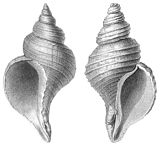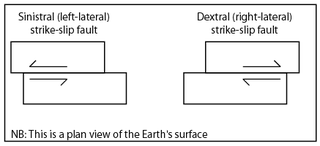- Sinistral and dextral
-
Not to be confused with Dexter and sinister.
Sinistral and dextral are scientific terms that describe chirality (“handedness”) or relative direction in a number of disciplines. The terms are derived from the Latin words for “left” (sinister) and “right” (dexter). Other disciplines have different terms (such as dextro- and laevo-rotary, in chemistry, or clockwise and anticlockwise in physics) or simply use left and right (as in anatomy)
Contents
Geology
Main article: Fault (geology)In geology the terms sinistral and dextral refer to the horizontal component of movement of blocks on either side of a fault or the sense of movement within a shear zone. These are terms of relative direction, as the movement of the blocks are described relative to each other when viewed from above. Movement is sinistral (left-handed) if the block on the other side of the fault moves to the left, or if straddling the fault the left side moves toward the observer. Movement is dextral (right-handed) if the block on the other side of the fault moves to the right, or if straddling the fault the right side moves toward the observer.[1]
Biology
Gastropods
Main article: Gastropod shell Left: The normally sinistral (left-handed) shell of Neptunea angulata.
Left: The normally sinistral (left-handed) shell of Neptunea angulata.
Right: The normally dextral (right-handed) shell of Neptunea despectaBecause the coiled shells of gastropods are asymmetrical, they possess a quality called chirality, the "handedness" of an asymmetrical structure.
By far the majority (over 90 %) [2] of gastropod species have dextral (right-handed) shells in their coiling, but a small minority of species and genera are virtually always sinistral (left-handed), and a very few species (for example Amphidromus perversus[3]) show an even mixture of dextral and sinistral individuals.
Flatfish
Main article: FlatfishIn flatfish, other than their flatness, their most obvious characteristic is their asymmetry, since both eyes are on the same side of the head in the adult fish. In some families of flatfish, the eyes are always on the right side of the body (dextral or right-eyed flatfish), and in others, they are always on the left (sinistral or left-eyed flatfish). The primitive spiny turbots include equal numbers of right and left sided individuals, and are generally less asymmetrical than the other families.[4]
See also
- Chirality
- Left and right (disambiguation)
- Laterality
- Helicity (disambiguation)
Notes
- ^ Park, R.G. (2004). Foundation of Structural Geology (3 ed.). Routledge. p. 11. ISBN 9780748758029. http://books.google.co.uk/books?id=ycASqdxSG3YC&pg=PA11&lpg=PA11&dq=sinistral+dextral+structural+geology#v=onepage&q=sinistral%20dextral%20structural%20geology&f=false.
- ^ Schilthuizen M. & Davison A. (2005). "The convoluted evolution of snail chirality". Naturwissenschaften 92(11): 504–515. doi:10.1007/s00114-005-0045-2.
- ^ Amphidromus perversus (Linnaeus, 1758)
- ^ Chapleau, Francois & Amaoka, Kunio (1998). Paxton, J.R. & Eschmeyer, W.N.. ed. Encyclopedia of Fishes. San Diego: Academic Press. xxx. ISBN 0-12-547665-5.
External links
Categories:- Chirality
- Scientific terminology
Wikimedia Foundation. 2010.


